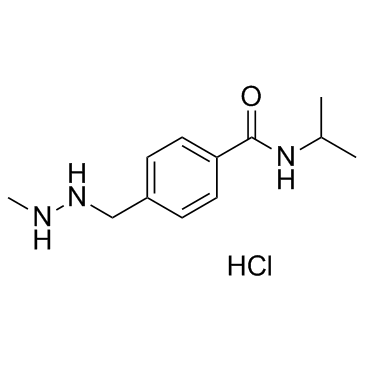
Procarbazine hydrochloride
CAS No. 366-70-1
Procarbazine hydrochloride( Indicarb | Matulane | Natulan | NSC 77213 )
Catalog No. M14259 CAS No. 366-70-1
Procarbazine hydrochloride (Matulane) is a hydrochloride salt form of procarbazine which is a polyfunctional alkylating compound used as an antineoplastic agent.
Purity : >98% (HPLC)
 COA
COA
 Datasheet
Datasheet
 HNMR
HNMR
 HPLC
HPLC
 MSDS
MSDS
 Handing Instructions
Handing Instructions
| Size | Price / USD | Stock | Quantity |
| 100MG | 35 | In Stock |


|
| 200MG | 57 | In Stock |


|
| 500MG | Get Quote | In Stock |


|
| 1G | Get Quote | In Stock |


|
Biological Information
-
Product NameProcarbazine hydrochloride
-
NoteResearch use only, not for human use.
-
Brief DescriptionProcarbazine hydrochloride (Matulane) is a hydrochloride salt form of procarbazine which is a polyfunctional alkylating compound used as an antineoplastic agent.
-
DescriptionProcarbazine hydrochloride (Matulane) is a hydrochloride salt form of procarbazine which is a polyfunctional alkylating compound used as an antineoplastic agent. Procarbazine is a cytostatic agent, meaning it strands cells midway through cell division, but it does not actively kill them. Procarbazine interferes with cells at a number of sites to prevent DNA and protein synthesis and mitosis. Procarbazine hydrochloride (Matulane) is used in the treatment of Hodgkin’s lymphoma and other malignant lymphomas including:- lymphosarcoma- reticulosarcoma- Brill-Symmers disease. Because procarbazine hydrochloride (Matulane) works differently to other anticancer agents,Procarbazine hydrochloride (Matulane) may be useful in the treatment of Ys that have not responded to other treatments.
-
In VitroCell Viability Assay Cell Line:L1210 cells Concentration:5 and 20 nM Incubation Time:1 hour Result:Showed 99.3% and 99.9% survival of cells at 5 mM and 20 mM, respectively.
-
In VivoAnimal Model:Male muta mouse (7–8 weeks old)Dosage:50 and 150 mg/kg Administration:Intraperitoneal injection; 50 and 150 mg/kg; once daily; 5 days Result:Increased the MN frequency appreciably, and observed micronucleus induction in the peripheral blood at 50 mg/kg.
-
SynonymsIndicarb | Matulane | Natulan | NSC 77213
-
PathwayCell Cycle/DNA Damage
-
TargetDNA/RNA Synthesis
-
RecptorDNA/RNA Synthesis
-
Research AreaCancer
-
Indication——
Chemical Information
-
CAS Number366-70-1
-
Formula Weight257.76
-
Molecular FormulaC12H19N3O·HCl
-
Purity>98% (HPLC)
-
SolubilityEthanol: 52 mg/mL (201.73 mM); Water: 52 mg/mL (201.73 mM)
-
SMILESCl.CNNCC1=CC=C(C=C1)C(=O)NC(C)C
-
Chemical Name——
Shipping & Storage Information
-
Storage(-20℃)
-
ShippingWith Ice Pack
-
Stability≥ 2 years
Reference
1.Ogawa K, et al. Mutat Res. 2003 Aug 5;539(1-2):145-55.
molnova catalog



related products
-
T2AA
T2AA is an inhibitor of proliferating cell nuclear antigen (PCNA) with IC50 of 1 μM for PCNA/PIP-box peptide interaction.
-
Myricetrin
Myricitrin, a flavonoid compound isolated from the root bark of Myrica cerifera, exerts antinociceptive effects.
-
SMN-C3
SMN-C3 (MV8T2MCK57) is an orally active modulator of SMN2 splicing, and has the potential to treat spinal muscular atrophy (SMA).



 Cart
Cart
 sales@molnova.com
sales@molnova.com


